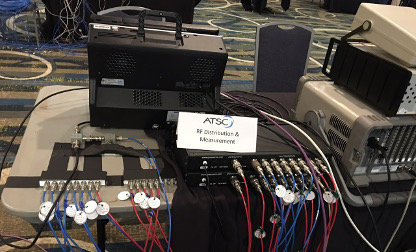Test We Must!
HUNT VALLEY, MD.—The latest in a series of equipment compatibility testing sessions known as “Plugfests” got underway in here on Jan. 23, bringing together more than a dozen manufacturers of equipment for the ATSC 3.0 television standard.
The five-day event was hosted by the Sinclair Broadcast Group’s systems division and marks the second time that SBG has offered such sponsorship. (Previous Plugfests were held in Shanghai, China and in Seoul, Korea. Last year’s Maryland trials were held in March.)
These Plugfests allow manufactures of exciters and gateways to work alongside receiver providers to ensure that all intended functionalities of the nascent standard’s features and capabilities are correctly ported over to viewing and listening devices. Numerous trials and tests are performed at each session to ensure that nothing is missed and that the standard will be ready for “primetime” when all modules are completed and offered to broadcasters to begin over-the-air transmissions.
NOT QUITE LIKE WITNESSING A MAJOR SPORTING EVENT

Cables, switchboxes, programmable logic arrays, test gear, along with plenty of silence and patience are key ingredients at Plugfests. (PHOTO CREDIT: Sinclair Broadcast Group)
Much of the work is repetitive and is performed in relative silence, save only for a coordinator to order the shifting of modes, or the announcement of the successful completion of one area of evaluation and the move to another area of investigation. To outside observers it’s rather boring (SBG’s vice president of advanced technology, Mark Aitken, has referred to it previously as “like watching paint dry.”) However, it is a very necessary step in closing loops and eliminating any unforeseen consequences in the eventual rollout of ATSC 3.0.
Participating at the Jan. 23-27 trials were Enensys Technologies, Triveni Digital, DigiCAP, ATBIS, NERC-DTV/CMIC, GatesAir, ETRI, ProTelevision Technologyand TeamCast on the exciter/gateway side of things, and receiving and test gear developers/manufacturers LG Electronics, ETRI, Triveni Digital, DekTec and Avateq Corp. Testing involved exciter/receiver compatibility, SFN compatibility and STL compatibility.
The professional video industry's #1 source for news, trends and product and tech information. Sign up below.
Louis Libin, one of the Plugfest coordinators and senior director of new technology at SBG, summed up the week’s activities as follows:
"Plugfest tests are always challenging but necessary; often modifications to the testing needs to be done, the cooperation is always great to see because [these are] normally competitors, but for the Plugfest, it is about correctly interpreting and adapting to the standard."
STAND BY FOR MORE
When asked about additional Plugfests, Libin was quick to acknowledge that work isn’t over yet.
“There will definitely be more Plugfests,” said Libin. “We need to ensure that all features, configurations and functionality works.”

ATSC President Mark Richer, along with DekTec’s Stephane Billat,and Tribune Broadcasting’s Bill Van Duynhoven, are all smiles about the progress made during the Maryland ATSC 3.0 Plugfest. (PHOTO CREDIT: Sinclair Broadcast Group)
Asked about a timeline for ATSC 3.0 completion and inauguration, Libin commented that it will be happening “much faster than we all think. The broadcasters need it badly, even the ones who don’t yet see it (the need for a new digital transmission standard). The business opportunities have tremendous potential; we see more opportunities all the time.
James E. O’Neal is a retired television engineer and served as TV Technology’s technology editor for nearly 10 years. He still contributes articles to the publication on a regular basis and serves as its technical advisor.
For more TV Technology coverage, see our ATSC 3.0 silo.
